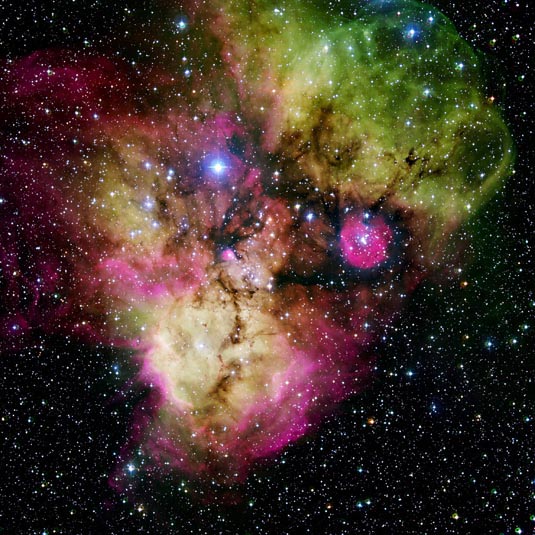
Description: Star Formation nebula
Position (J2000): R.A. 07h 52m 19.3s Dec -26 26m 30s
Constellation: Puppis
Distance: 13,000 light years
Image Credit: ESO
Release Date: December 25, 2005
Related images: 2005 2010 2018
ABOUT THIS IMAGE:
Just like Charles Dickens' Christmas Carol takes us on a journey into past, present and future in the time of only one Christmas Eve, two of ESO' s telescopes captured various stages in the life of a star in a single image.
This image shows the area surrounding the stellar cluster NGC 2467, located in the southern constellation of Puppis (" The Stern"). With an age of a few million years at most, it is a very active stellar nursery, where new stars are born continuously from large clouds of dust and gas.
The image, looking like a colorful cosmic ghost or a gigantic celestial Mandrill (NGC 2467 is also sometimes referred to as the " Skull and Crossbones"), contains the open clusters Haffner 18 (center) and Haffner 19 (middle right: located inside the smaller pink region - the lower eye of the Mandrill), as well as vast areas of ionized gas.
The bright star at the centre of the largest pink region on the bottom of the image is HD 64315, a massive young star that is helping to shape the structure of the whole nebular region.
In the center of the picture, Haffner 18, a group of mature stars that have already dispersed their birth nebulae, represents the completed product or immediate past of the star formation process. Located at the bottom left of this cluster, a very young star, just came into existence and, still surrounded by its birth cocoon of gas, provides insight into the very presence of star birth. Finally, the dust clouds towards the right corner of the image are active stellar nurseries that will produce more new stars in the future.
Haffner 18 contains about 50 stars, among which several short lived, massive ones. The massive star still surrounded by a small, dense shell of hydrogen, has the rather cryptic name of FM3060a. The shell is about 2.5 light-years wide and expands at a speed of 20 km/s. It must have been created some 40,000 years ago. The cluster is between 25,000 and 30,000 light-years away from us.
The image was taken with the Wide-Field Imager camera at the 2.2m MPG/ESO telescope located at La Silla, in Chile.